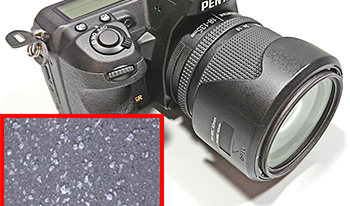3.
We modeled the relationships among the five impression factors and the characteristics of crinkle-finished surface images. We measured the image characteristics using the processes described below and modeled the relationship using multiple regression analyses.
3.1
Methods
Figure
6 shows a schematic diagram of the multi-angle measurement system that we constructed to collect images of crinkle-finished samples. The system can measure the samples at various lighting and camera angles. The lighting device is a Xe light source (MAX-303, Asahi Spectra Co., Ltd., Tokyo, Japan). The light beam is parallelized by a rod lens and a telecentric lens. The camera device is an
XY Z camera (RTC-21, Ikegami Tsuhinki Co., Ltd., Tokyo, Japan). The
XY Z camera measures
XY Z tristimulus values as a pixel value [
8]. In this experiment, the resolution of the test images is 40 pixels/mm. The lighting and camera angles are defined as angles from the line that is normal to the measuring surface.
Figure 6.
Multi-angle measurement system.
![]()
We measured the paint surfaces of the crinkle-finished samples under eight conditions (Figure
7). Table
V shows the size of the region of interest (ROI) under each condition. In this report, the measurement conditions are written as “lighting angle [deg]/camera angle [deg].”
Figure 7.
Conditions of the test images.
![]()
Table V.
ROI size for each condition.
| Camera angle | Size of ROI | Size of ROI |
|---|
| (deg) | (pixel) | (mm) |
|---|
| 0 | 600 × 600 | 15.0 × 15.0 |
| 45 | 424 × 424 | 10.4 × 10.4 |
| 60 | 300 × 300 | 7.5 × 7.5 |
Figure
8 shows example test images. Figs.
8(a), (b), and (c) are images of sample A1 under three different conditions (
,
, and
, respectively). These three images were measured at the same position. Here, (c) is part of a region of (b) and (b) is part of a region of (a). The sizes of ROIs were changed due to changing camera angles (shown in Table
V). The brightness of particles changes in Fig.
8(a) and (b) as the red circled areas show. In Figs.
8(a) and (c), there are bright points that are smaller than the particles (circled in green).
Figure 8.
The results of measurement images.
![]()
We calculated the image characteristics using the following methods. First, we measured the Y-channel images of the samples
Y (
i,
j) and a standard white target
Y s(
i,
j) using the
XY Z camera under each condition, where (
i,
j) denote spatial coordinates. Then, we calculated the brightness
L∗ of each sample to consider human visual characteristics. The
L∗ images of samples
L∗(
i,
j) were calculated as defined by the International Commission on Illumination as follows:
Here,
f(
t) is defined as in the following equations:
Finally, we calculated the following nine image characteristics:
(1) Average L∗
This characteristic is the average value of L∗ in the ROI.
(2) Standard deviation ofL∗
This characteristic is the standard deviation of L∗ in the ROI.
(3) Average L∗of the base and particle regions
The L∗-channel images in the ROI were divided into base and particle regions using a threshold set for the average value of L∗ in the samples. The average values of L∗ in each region are defined as the average L∗ values of the base and particle areas, respectively.
(4) Contrast ofL∗
This value is the absolute value of the difference between the average L∗ values of the base and particles.
(5) Low and high spatial frequency characteristics
Figure
9 shows how the spatial frequency characteristics are calculated. As shown in Fig.
9(a), we calculated spatial frequency using the Fourier transformation of the test images and transformed the results into one-dimensional values by averaging the spatial frequency concentrically. As shown in Fig.
9(b), the integral of the one-dimensional spatial frequency values over a frequency range (0.5–2.0 and 4.0–10 cycles/mm for low and high spatial frequencies, respectively) is used as a spatial frequency characteristic [
4]. The low spatial frequency characteristic corresponds to the size of the larger particles and the high spatial frequency characteristic corresponds to that of the smaller particles.
Figure 9.
(a) Procedure for calculating frequency characteristics. (b) Ranges of low- and high-frequency characteristics.
![]()
(6) Number of particles
We binarized the L∗-channel images using a threshold to divide them into particle and base regions. Then, we calculated the number of particles in the image.
(7) Average particle area
The average particle area was calculated from each connected component of the binarized images.
(8) L∗ change at and
The difference of the average L∗ under highlighted (specular reflection) conditions and shaded (diffuse reflection) conditions is defined as the L∗ change. The L∗ change at is the difference between (specular) and (diffuse) images. The L∗ change at is the difference between (specular) and (diffuse) images.
(9) Particle L∗change
The difference in L∗ values for the particle regions between near-specular and diffuse conditions is defined as the particle L∗ change. The difference between and was calculated.
Image characteristics 1–9 were calculated for each of the eight test conditions (see Fig.
4). Therefore, a total of 75 image characteristics were calculated for each sample.
We derived formulas to predict the five impression factors using multiple regression analyses with a stepwise method. In these analyses, the objective variables are the factor scores of the five factors and the explanatory variables are the image characteristics. The values of the image characteristics have dissimilar ranges. Therefore, the standardized Z scores of the image characteristics were used as the explanatory variables.

 Find this author on Google Scholar
Find this author on Google Scholar Find this author on PubMed
Find this author on PubMed